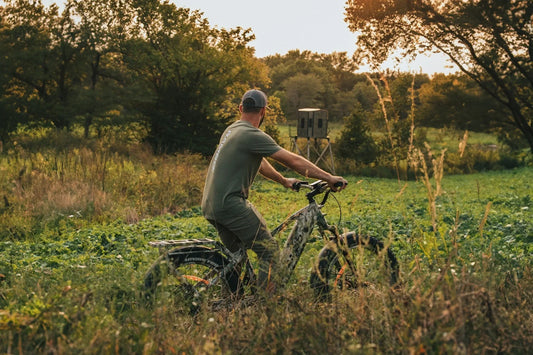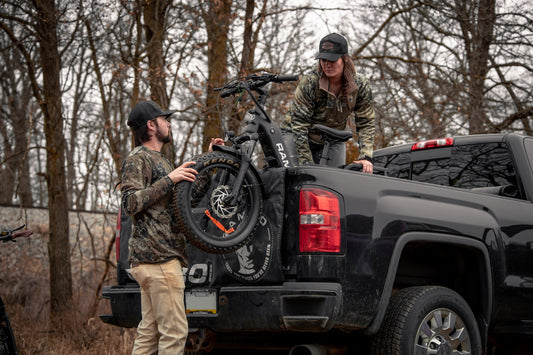Utilizing E-Bikes for Foraging Wild Edibles in Appalachia
It won’t be long before the hills and hollows of Appalachia are re-visited by one of the most hunted sets of annual flora — wild edibles. From ramps to fungi, folks will be grabbing their foraging equipment and heading out the door to begin their search.
Yet, while most will put miles on their rubber soles, others can outlast most of these edible hunters with e-bikes. And, though some get bristly at the thought of a motorized bike damaging trails or the general areas these edibles grow in, that notion couldn’t be further from the truth.
Aside from a lack of carbon emissions, proper use of e-bikes doesn’t disturb local ecosystems any more than a mountain bike or hiker would. Further, e-bikes provide a simple and, oftentimes, an easier way to scout for and collect ramps. In that vein, here are some tips on how to find edibles as well as how to set up your e-bike for success.
How to locate various edibles on public land
One of the major benefits of scouting for wild edibles with an e-bike is that you can cover more ground, faster. That said, any reconnaissance tool isn’t helpful if you don’t know what you’re looking for.
Here are major factors to consider when searching for two of the most popular edibles in Appalachia, ramps and morels.
How to locate ramps on public land
Ramps are one of the easiest wild edibles to find from a trail. Its leaf structure jutting up from the ground is nearly unmistakable if you’ve ever sourced the plant and is unique enough that it still catches the eyes of those not introduced to it.
The plant tends to have a three-leaf structure, though often you may come across a plant with two leaves or just a single leaf. Further, ramps can grow up to a foot tall and can have purple or red hued stems; just note, that some will have redder or fully white stems. They also grow in small patches and should be sourced from mid-March to their peak maturity in early May, as they start to flower in mid-June. Simply, ramps like moderate temperatures, between 50 and 60 degrees.
Ramps also love to grow through wooded areas with well-draining soil. Because the plant’s annual growth is often heralded alongside the influx of trout fishermen hitting wooded creeks with mixed sunlight, these are excellent places to start your search. But target deciduous forests, especially those heavily populated with birch, beech, maple, poplar, and oak trees.
As with all wild plants, know for sure what you’re foraging is edible. Two lookalikes will poison you: false hellebore and lily-of-the-valley. False hellebore is a little easier to distinguish, as it has pleated leaves and does not smell like an onion. New England saw an uptick in poisoning by false hellebore in recent years, specifically Vermont, but this plant grows throughout the Eastern U.S. and should be left alone.
Lily-of-the-valley can be harder to distinguish. Its leaf and shoot structure are very similar to a ramp, but one immediate tell is that it has a flower stem growing next to the leaves as soon as it sprouts. Ramps will not flower until later in the season when the plant is past its prime. Ramp leaves also have individual stems running to the shoot, whereas a lily-of-the-valley’s leaves are all connected to the shoot in what looks like one package. Finally, ramp roots grow out of a bulb, whereas a lily-of-the-valley does not with roots sticking out of the shoot.
If all else fails, smell the plant; tear part of the leaf off and, if it smells like an onion, you’ve got a ramp.

How to locate morels on public land
Morels are becoming increasingly popular in the public eye and with their popularity comes plenty of questions.
First, when and where to find them? Morels like to grow when temperatures are warm in the day and cooler at night (think 65- to 70-degree days, 45- to 50-degree nights) and explode out of the ground after a good rainstorm. Additionally, they don’t tend to start growing until soil temperatures reach 50 degrees. Lastly, they love to grow around certain trees and are an edge mushroom, so target oak, elms, ash, and apple trees in transitional cover.
A few other targeting tips: look for mayapples, disturbed areas (especially burns), and dead or dying trees. Morels love to grow around these areas. Next, in the early portion of their season, search south-facing slopes before focusing more on north-facing slopes later in the spring; this is due to south-facing land warming up sooner than its counterpart.
Finally, keep in mind poisonous lookalikes. Multiple resources note that “true morels” are more symmetrical in shape, have inward pits and distinct ridge structures, and are hollow from the tip of the mushroom cap to the end of the stem, while “false morels” are irregularly shaped, can bulge outward, and are not hollow.

What E-Bike should you consider for foraging wild edibles?
You’ve got the know-how, so, next, what e-bike is best for the task? Without a doubt, we recommend the Rambo Savage 2.0.
The Savage 2.0 is the latest iteration in the Savage line of bikes, and an excellent option for beginning e-bike riders and longtime owners alike. The Savage 2.0 is a high-performance model, offering a peak power of 1,200 watts and nominal power of 1,000 watts as well as 90 N.m. of torque; simply, the rocky, hilly terrain of Appalachia won’t impede this fat-tire model, taking you further into the woods for longer periods of time than other edible hunters.
In that vein, the Savage 2.0 is equipped with a 48-volt, 15Ah battery, and users will get 48 miles of range out of a single charge. The bike can be also adjusted for any situation or local regulations. Finally, the 6061 T6 aluminum frame is highly durable despite its lightweight nature and will give users years of adventure.
E-Bike Accessories that Make Wild Edible Foraging Easier
Rambo offers a line of accessories that will make any foraging trip easier, but, for the task, a simple setup is all that’s needed.
Pairing either the black accessory bag is an excellent, minimalist option for short or halfway trips, allowing you to store tools or smaller items in a safe spot and off your back. For a little more packing ability, consider the double saddle accessory bags, giving you double the space for tools, your edibles, and more, while also giving you more space for longer day trips.
Both accessory bag add-ons need to be installed with the rear XL luggage rack, however, so keep that in mind when outfitting your bike. The XL luggage rack also gives you the ability to lash down items such as a small- to medium-sized backpack should you choose to not buy the accessory bags.
Finally, the last accessory worth considering is the Pro Hunter flashlight. More so for its safety component, the Pro Hunter flashlight provides riders with an ultra-bright white light, perfect for trips that go longer than expected, or for the early morning jaunts to your honey hole.

Final thoughts on the benefits of e-bikes for foraging
When foraging for wild edibles with an e-bike, many factors come into play. Most importantly, how is your relationship with nature impacted?
E-bikes are widely accepted as a net positive for the environment, from their lack of carbon emissions to their non-invasive motors and easy rider adaptability, e-bikes are central for getting more people further into public land to have unforgettable experiences. Because of their rising popularity, e-bikes are also being watched by natural resources groups and government agencies for how they can place restrictions on their use. Check existing regulations and follow them so as not to damage the application’s good reputation.
Speaking of regulations, also research state and federal guidelines for foraging wild edibles in general, as well as on public lands. While ramps and morels are widely allowed to be picked, some states may currently or may in the future place restrictions on the act of foraging these plants as it becomes more popular.
So, before those delicious plants and fungi begin to pop-up all-over Appalachia, make sure you’re squared away with an outfitted e-bike. It’ll make your pursuits more enjoyable and so much easier.



